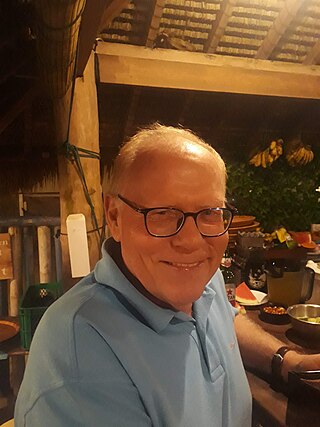
Heterosexuality is romantic attraction, sexual attraction or sexual behavior between people of the opposite sex or gender. As a sexual orientation, heterosexuality is "an enduring pattern of emotional, romantic, and/or sexual attractions" to people of the opposite sex; it "also refers to a person's sense of identity based on those attractions, related behaviors, and membership in a community of others who share those attractions." Someone who is heterosexual is commonly referred to as straight.

Sexual orientation is an enduring personal pattern of romantic attraction or sexual attraction towards persons of specific sexes or genders and the degree to which a person feels sexual or romantic attraction. Patterns are generally categorized under heterosexuality, homosexuality, and bisexuality, while asexuality is sometimes identified as the fourth category.
Robert Allan Humphreys (1930–1988), known as Laud Humphreys, was an American sociologist and Episcopal priest. He is noted for his research into sexual encounters between men in public bathrooms, published as Tearoom Trade (1970) and for the questions that emerged from what was overwhelmingly considered unethical research methods. He influenced generations of scholars who research issues related to sexuality and sexual identity.
The General Social Survey (GSS) is a sociological survey created in 1972 by the National Opinion Research Center (NORC) at the University of Chicago and funded by the National Science Foundation. The GSS collects information biannually and keeps a historical record of the concerns, experiences, attitudes, and practices of residents of the United States.
Peter Shawn Bearman is an American sociologist, notable for his contributions to the fields of adolescent health, research design, structural analysis, textual analysis, oral history and social networks. He is the Jonathan R. Cole Professor of Social Science in the Department of Sociology at Columbia University, the President of the American Assembly at Columbia University, as well as the director of the Interdisciplinary Center for Innovative Theory and Empirics (INCITE). He is also the founding director of the Institute for Social and Economic Research and Policy, and co-founding director of Columbia's Oral History Master of Arts Program, the first oral history masters program in the country. He was elected a Fellow of the American Academy of Arts and Sciences in 2008, a member of the National Academy of Sciences in 2014, a Guggenheim Fellow in 2016, and a member of the National Academy of Medicine in 2019.

The University of Chicago Harris School of Public Policy is the public policy school of the University of Chicago in Chicago, Illinois, United States. It is located on the University of Chicago's main campus in Hyde Park. The school's namesake is businessman Irving B. Harris, who made a donation that established the Harris School in 1986. In addition to policy studies and policy analysis, the school requires its students to pursue training in economics and statistics through preliminary examinations and course requirements. Harris Public Policy offers joint degrees with the Booth School of Business, Law School, School of Social Service Administration, and the Graduate Division of the Social Sciences.
NORC at the University of Chicago is one of the largest independent social research organizations in the United States. Established in 1941 as the National Opinion Research Center, its corporate headquarters is located in downtown Chicago, with offices in several other locations throughout the United States. Organized as an independent corporation, more than half its board comes from faculty and administration of the University of Chicago. It also jointly staffs some of the university's academic research centers.

The Klein Sexual Orientation Grid (KSOG) developed by Fritz Klein attempts to measure sexual orientation by expanding upon the earlier Kinsey scale. Fritz Klein founded the American Institute of Bisexuality in 1998 which is continuing his work by sponsoring bisexual-inclusive sex research, educating the general public on sexuality, and promoting the bisexual community.

A sexless marriage is a marital union in which little or no sexual activity occurs between the two spouses. The US National Health and Social Life Survey in 1992 found that 2% of married respondents aged 18 to 59 reported no sexual intimacy in the past year. Comparatively 92% of married respondents aged 65 to 80 reported no sexual intimacy in the past year. The definition of a non-sexual marriage is often broadened to include those where sexual intimacy occurs fewer than ten times per year, in which case 20 percent of the couples in the National Health and Social Life Survey would be in the category. Other studies show that 10% or less of the married population below age 50 have not had sex in the past year. In addition less than 20% report having sex a few times per year, or even monthly, under the age 40.
Sexual capital or erotic capital is the social power an individual or group accrues as a result of their sexual attractiveness and social charm. It enables social mobility independent of class origin because sexual capital is convertible, and may be useful in acquiring other forms of capital, including social capital and economic capital.

Gilbert H. Herdt is Emeritus Professor of Human Sexuality Studies and Anthropology and a Founder of the Department of Sexuality Studies and National Sexuality Resource Center at San Francisco State University. He founded the Summer Institute on Sexuality and Society at the University of Amsterdam (1996). He founded the PhD Program in Human Sexuality at the California Institute for Integral Studies, San Francisco (2013). He conducted long term field work among the Sambia people of Papua New Guinea, and has written widely on the nature and variation in human sexual expression in Papua New Guinea, Melanesia, and across culture.
John H. Gagnon was a pioneering sociologist of human sexuality who wrote and edited 15 books and over 100 articles. He collaborated with William Simon to develop the piece he is perhaps best recognized for: "Sexual Conduct: The Social Sources of Human Sexuality" (1973). He was Distinguished Emeritus Professor of Sociology at the State University of New York at Stony Brook, where he taught and from 1968 to 1998. In that same time frame, he also dedicated himself to advancing the field of sociology through his research.

Douglas Bernard Kirby was senior research scientist for ETR Associates in Scotts Valley, California, and one of the world’s leading experts on the effectiveness of school and community programs in the reduction of adolescent sexual risk-taking behaviors. In recent years he had also undertaken research and analysis on the impact of HIV/AIDS prevention programs in Uganda under the auspices of the World Health Organization, USAID, and other organizations.

The demographics of sexual orientation and gender identity in the United States have been studied in the social sciences in recent decades. A 2022 Gallup poll concluded that 7.1% of adult Americans identified as LGBT. A different survey in 2016, from the Williams Institute, estimated that 0.6% of U.S. adults identify as transgender. As of 2022, estimates for the total percentage of U.S. adults that are transgender or nonbinary range from 0.5% to 1.6%. Additionally, a Pew Research survey from 2022 found that approximately 5% of young adults in the U.S. say their gender is different from their sex assigned at birth.
Martin S. Weinberg is an American sociologist whose work frequently involves human sexuality. His major areas of interest include sociology of the body, sociology of deviance and control, and interpretive sociology.
William Simon (1930–2000) was a sociologist of human sexualities between 1970 and 2000. His co-authored book, Sexual Conduct: The Social Sources of Human Conduct played a major role in shaping the contemporary sociology of sexuality and critical sexualities studies. His work helped pioneer a theory of sexual scripting and he was a gentle but radical advocate of sexual tolerance. He was an early advocate of gay rights and testified against obscenity laws.

Peter Henry Rossi was a prominent sociologist best known for his research on the origin of homelessness, and documenting the changing face of American homelessness in the 1980s. Rossi was also known for his work devising ways to evaluate federally funded initiatives in education, health services, crime control, and housing. He influentially applied his sociological expertise to affect related policy-making and funding agencies. At his death, he was the Stuart A. Rice professor emeritus of Sociology and the director emeritus of the Social and Demographic Research Institute (SADRI) at the University of Massachusetts Amherst.
Joseph Galaskiewicz is an American sociologist and Professor of Sociology at the University of Arizona, known for his work on interorganizational relations and social network analysis.

Linda Joan Waite is a sociologist and social demographer. She is the George Herbert Mead Distinguished Service Professor of Sociology at the University of Chicago. Waite is also a Senior Fellow at the NORC at the University of Chicago and Principal Investigator on the National Social Life, Health, and Aging Project (NSHAP). In 2018, she was elected to the American Academy of Arts and Letters.
Erin York Cornwell is an American sociologist. She is associate professor of sociology at Cornell University. She earned her Ph.D. at the University of Chicago in 2008, where she worked with Linda Waite, Edward Laumann, and Kathleen Cagney. She specializes in survey research methods, and has made numerous contributions to sociology of law, urban sociology, and the sociology of health.








